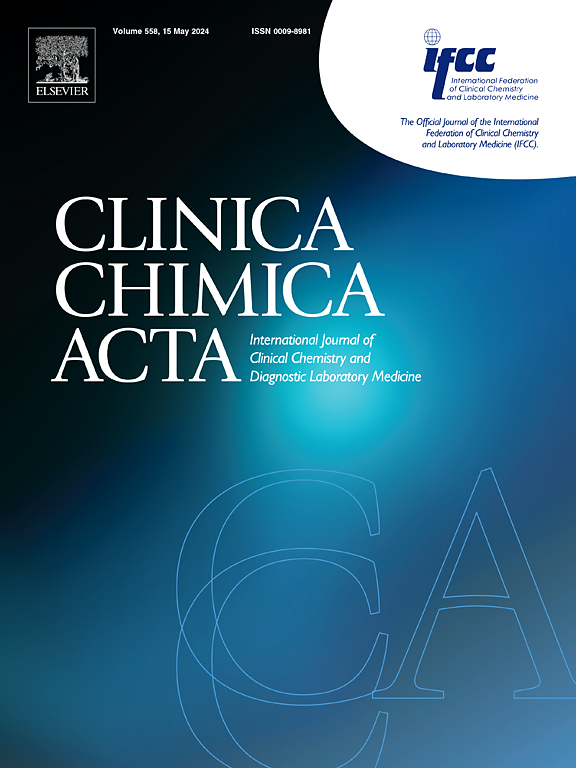A rapid CRISPR/Cas12a-based assay for the detection of HIV-1 Clade C in infants
IF 2.9
3区 医学
Q2 MEDICAL LABORATORY TECHNOLOGY
引用次数: 0
Abstract
Background
Early detection of HIV-1 infection is essential for initiating antiretroviral therapy (ART) to suppress viremia and prevent disease progression. Timely diagnosis, especially in infants, is critical as rapid antibody-based serology tests are ineffective due to the presence of maternal antibodies.
Methods
We developed a CRISPR/Cas12a-based HIV-1 detection assay by optimizing components for coupled isothermal preamplification using recombinase polymerase amplification (RPA). The assay targeted the conserved region in the pol gene specific to HIV-1 with the designed CRISPR RNA (crRNA). CRISPR/Cas12a-mediated cleavage of viral cDNA was visualized through the collateral cleavage of a single-stranded DNA-FAM-BQ reporter, enabling rapid and visually detectable outcomes. The performance of the assay was evaluated using plasma from 41 HIV-1 Clade C (HIV-1C) seropositive individuals, including 28 HIV-1C infected infant samples, HIV-1 Indian Clade C and Clade B genome plasmids, viral disease control DNA/RNA samples (Influenza, RSV, Parvovirus, HPIV, CMV, and HBV), and 31 healthy donor plasma samples. Sensitivity and specificity were assessed, and detection was performed using fluorescence, visual readout, and lateral flow dipsticks.
Results
The CRISPR/Cas12a-based HIV-1 Clade C detection assay achieved a sensitivity of 96 % and a specificity of 92.65 %. The assay successfully provided results through both fluorescence and visual readouts and was compatible with lateral flow dipstick formats, facilitating easy and rapid detection.
Conclusions
The developed CRISPR/Cas12a-based HIV-1C detection assay demonstrates high sensitivity and specificity for Clade C, indicating its potential as a robust point-of-care molecular diagnostic tool for HIV-1C. Additionally, it may serve as a rapid nucleic acid test alternative for detecting mother-to-child transmission of HIV-1C in infants under two years of age, where traditional antibody-based tests are ineffective. This assay holds promise for improving early HIV-1 diagnosis and timely initiation of ART, ultimately contributing to better disease management and outcomes.

一种基于CRISPR/ cas12的婴儿HIV-1进化支C快速检测方法
背景:检测HIV-1感染对于启动抗逆转录病毒治疗(ART)以抑制病毒血症和预防疾病进展至关重要。及时诊断,特别是对婴儿,至关重要,因为基于抗体的快速血清学检测由于母体抗体的存在而无效。方法利用重组酶聚合酶扩增(recombinase polymerase amplification, RPA)技术优化等温预扩增组份,建立基于CRISPR/ cas12的HIV-1检测方法。该实验利用设计的CRISPR RNA (crRNA)靶向HIV-1特异性pol基因的保守区域。通过单链DNA-FAM-BQ报告基因的侧切,可以看到CRISPR/ cas12a介导的病毒cDNA切割,从而实现快速和视觉检测的结果。使用41例HIV-1进化支C (HIV-1C)血清阳性个体的血浆,包括28例HIV-1C感染婴儿样本、HIV-1印度进化支C和进化支B基因组质粒、病毒疾病控制DNA/RNA样本(流感、RSV、细小病毒、HPIV、CMV和HBV)和31例健康供体血浆样本,对该检测的性能进行了评估。评估敏感性和特异性,并使用荧光、视觉读数和侧流量试纸进行检测。结果基于CRISPR/ cas12的HIV-1 Clade C检测方法灵敏度为96%,特异性为92.65%。该试验成功地通过荧光和视觉读数提供结果,并与侧流试纸格式兼容,便于快速检测。结论基于CRISPR/ cas12的HIV-1C检测方法对C进化枝具有高灵敏度和特异性,表明其有潜力成为HIV-1C的即时分子诊断工具。此外,它可以作为一种快速的核酸检测替代方法,用于检测两岁以下婴儿的HIV-1C母婴传播,传统的基于抗体的检测方法在两岁以下婴儿中无效。这种检测有望改善HIV-1的早期诊断和及时启动抗逆转录病毒治疗,最终有助于更好的疾病管理和结果。
本文章由计算机程序翻译,如有差异,请以英文原文为准。
求助全文
约1分钟内获得全文
求助全文
来源期刊

Clinica Chimica Acta
医学-医学实验技术
CiteScore
10.10
自引率
2.00%
发文量
1268
审稿时长
23 days
期刊介绍:
The Official Journal of the International Federation of Clinical Chemistry and Laboratory Medicine (IFCC)
Clinica Chimica Acta is a high-quality journal which publishes original Research Communications in the field of clinical chemistry and laboratory medicine, defined as the diagnostic application of chemistry, biochemistry, immunochemistry, biochemical aspects of hematology, toxicology, and molecular biology to the study of human disease in body fluids and cells.
The objective of the journal is to publish novel information leading to a better understanding of biological mechanisms of human diseases, their prevention, diagnosis, and patient management. Reports of an applied clinical character are also welcome. Papers concerned with normal metabolic processes or with constituents of normal cells or body fluids, such as reports of experimental or clinical studies in animals, are only considered when they are clearly and directly relevant to human disease. Evaluation of commercial products have a low priority for publication, unless they are novel or represent a technological breakthrough. Studies dealing with effects of drugs and natural products and studies dealing with the redox status in various diseases are not within the journal''s scope. Development and evaluation of novel analytical methodologies where applicable to diagnostic clinical chemistry and laboratory medicine, including point-of-care testing, and topics on laboratory management and informatics will also be considered. Studies focused on emerging diagnostic technologies and (big) data analysis procedures including digitalization, mobile Health, and artificial Intelligence applied to Laboratory Medicine are also of interest.
 求助内容:
求助内容: 应助结果提醒方式:
应助结果提醒方式:


